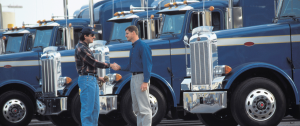
It’s not an overstatement to say that the global economy depends on truck drivers.
With over 30% of the world’s food supplies transported by truck each year, food and beverage delivery drivers play a critical role in maintaining restaurants, farms, businesses, and everyday families across the globe.
Keep reading to find out what this important trucking job entails, and our four essential tips to maximize operational efficiency and find success as a food and beverage delivery driver.
Top Advice for Food and Beverage Delivery
In many ways, carrying food and beverage as freight is similar to other kinds of trucking. However, there are unique aspects and additional responsibilities that come with transporting perishable goods.
By understanding these expectations and preparing for the unique aspects of food and beverage delivery, you can navigate the challenges and excel in your role as a delivery driver.
Ensuring proper load management and temperature control are critical to safely handling food and beverage products and maintaining FDA standards. Drivers must follow the FDA’s food transportation regulations at all times, which aim to prevent practices during transportation that create food safety risks, such as improper refrigeration or inadequate cleaning of vehicles.
Be sure to remain up to date on current regulations, such as required sanitary practices and temperature monitoring protocols. Regularly check the FDA website and subscribe to industry updates to stay informed about any changes in the regulations. Proper load management involves organizing cargo to prevent damage and ensure stability, while also considering weight distribution to avoid vehicle control issues.
Temperature control is equally important. Use calibrated thermometers to verify that refrigeration units are functioning correctly and maintain the required temperatures throughout the journey. Record and log temperatures at regular intervals to ensure compliance and to provide documentation in case of an audit.
Route efficiency planning and timeliness are crucial when carrying any freight, but especially with perishable items like food and beverages. Unlike some freight, food and beverage shipments are assigned a must-arrive-by date. If there are any delays in delivery, suppliers are usually charged a rescheduling fee on top of the money losses from wasted product. This puts pressure on delivery drivers to plan routes efficiently to minimize delivery time.
To ensure timely delivery, consider using route planning software that considers real-time traffic data, road conditions, and weather forecasts. This technology can help identify the quickest and most efficient routes, avoiding potential delays. Additionally, always have a contingency plan in place for unexpected disruptions, such as road closures or vehicle breakdowns.
It also helps to regularly maintain your vehicle to reduce the risk of breakdowns. Perform pre-trip inspections to check for any issues that could cause delays, such as tire pressure, fluid levels, and the functionality of refrigeration units.
Product knowledge is important when carrying freight like food and beverages that can have specific requirements and unique challenges. Familiarize yourself with the products you’re delivering to ensure that food quality is maintained throughout transportation.
Be sure to be aware of any special handling requirements, such as fragile items or perishable goods. Stay informed about the shelf life and storage conditions of the items you’re transporting. Knowing how long products can safely remain at various temperatures and under different conditions will help you prioritize deliveries and reduce the risk of spoilage. For example, frozen foods must be kept below a certain temperature, while fresh produce might have different humidity requirements.
Good customer service and communication are essential to finding success as a food and beverage delivery driver. Be courteous and professional when interacting with customers, ensuring you greet them politely and address any concerns they may have.
Clear and timely communication about delivery status, including any potential delays, helps build trust and reliability. Provide updates on expected arrival times and promptly inform customers and dispatch of any changes.
Remember, excellent service can lead to repeat business and positive reviews, which are invaluable in this competitive industry.
Looking for more information on truck driving jobs and industry trends? Be sure to check out the rest of our Truck Driver Blog posts and connect with us on social media.











